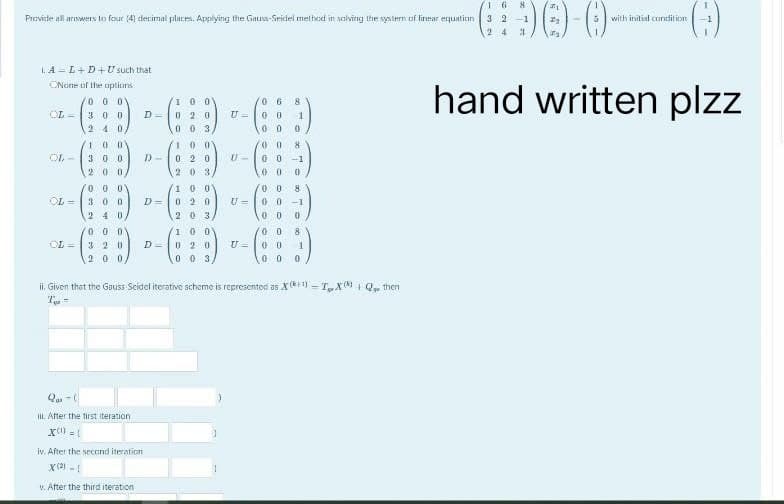Provide all answers to four (4) decimal places. Applying the Gauss-Seidel method in solving the system of linear equation LA L+D+U such that CNone of the options 000 300 2 40, 06 8 U= 00 1 D= 00 0 1 00 00 8 100 0 20 003 100 020 203, 100 020 OL- 300 D- U- 00-1 200 00 0 000 00 8 OL-> 300 D= U= 00 -1 240 203 00 0 0001 10 0 00 8 U= 00 1 320 D= 020 200, 003 00 0 ii. Given that the Gauss Seidel iterative scheme is represented as X(+1)-TX Q then Qu-( . After the first iteration X=1 iv. After the second iteration X(²)-1 v. After the third iteration with initial condition 32 -1 By 24 3 hand written plzz
Provide all answers to four (4) decimal places. Applying the Gauss-Seidel method in solving the system of linear equation LA L+D+U such that CNone of the options 000 300 2 40, 06 8 U= 00 1 D= 00 0 1 00 00 8 100 0 20 003 100 020 203, 100 020 OL- 300 D- U- 00-1 200 00 0 000 00 8 OL-> 300 D= U= 00 -1 240 203 00 0 0001 10 0 00 8 U= 00 1 320 D= 020 200, 003 00 0 ii. Given that the Gauss Seidel iterative scheme is represented as X(+1)-TX Q then Qu-( . After the first iteration X=1 iv. After the second iteration X(²)-1 v. After the third iteration with initial condition 32 -1 By 24 3 hand written plzz
Linear Algebra: A Modern Introduction
4th Edition
ISBN:9781285463247
Author:David Poole
Publisher:David Poole
Chapter2: Systems Of Linear Equations
Section2.2: Direct Methods For Solving Linear Systems
Problem 4CEXP
Related questions
Question

Transcribed Image Text:16
8
-() ()-0)-(:)
3 2
-1
with initial condition
24
hand written plzz
Provide all answers to four (4) decimal places. Applying the Gauss-Seidel method in solving the system of linear equation
LA L+D+U such that
ONone of the options
000
06 8
COL= 300
D=
U=
1
100
0 2 0
003,
100
0 20
00
00 0
2 40,
100
OL-
30.0 D)-
U-
00 8
00-1
0
200
000
100
00
8
00 -1
300 D= 020
U=
240
203
00 0
000
100
0 8
320
D=
020
U= 00 1
00 0
2 0 0/
003,
ii. Given that the Gauss Seidel iterative scheme is represented as X(+1)-TX Q₁ then
T-
Qui-(
ill. After the first iteration
X=1
iv. After the second iteration
X(²) - 1
v. After the third iteration
Expert Solution
This question has been solved!
Explore an expertly crafted, step-by-step solution for a thorough understanding of key concepts.
Step by step
Solved in 6 steps with 6 images

Recommended textbooks for you

Linear Algebra: A Modern Introduction
Algebra
ISBN:
9781285463247
Author:
David Poole
Publisher:
Cengage Learning

Algebra & Trigonometry with Analytic Geometry
Algebra
ISBN:
9781133382119
Author:
Swokowski
Publisher:
Cengage

Linear Algebra: A Modern Introduction
Algebra
ISBN:
9781285463247
Author:
David Poole
Publisher:
Cengage Learning

Algebra & Trigonometry with Analytic Geometry
Algebra
ISBN:
9781133382119
Author:
Swokowski
Publisher:
Cengage